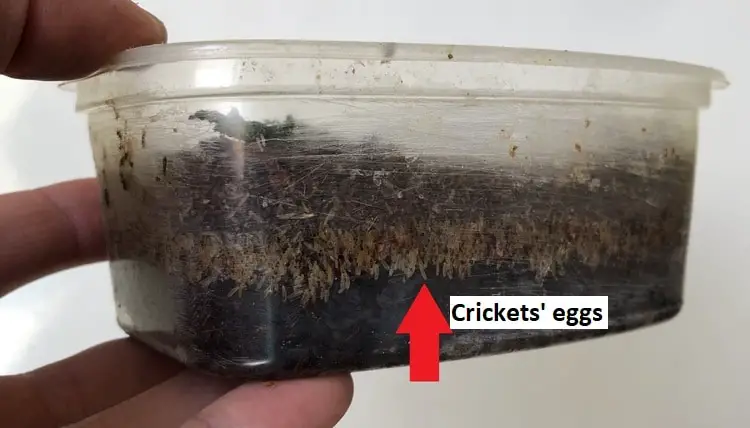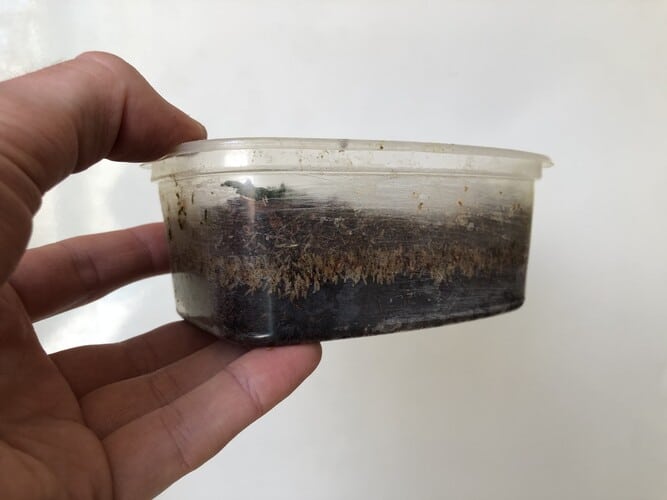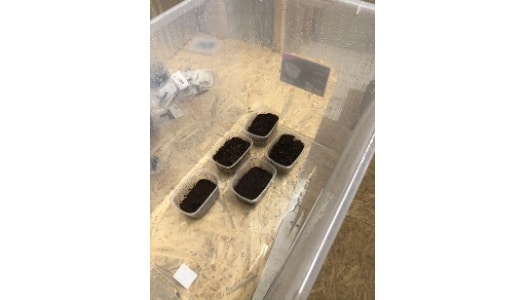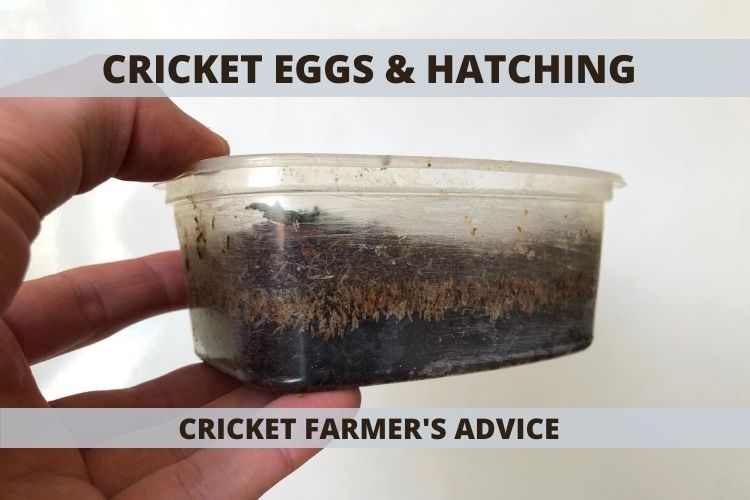When I started farming crickets 2 years ago it was all new to me. Cricket eggs was one of the most difficult topic for me to crack (pun intended).
In this article I will share my cricket farmer’s experience about cricket eggs and their hatching.
At the end I will share the list of items from Amazon which you will need to properly incubate and successfully hatch cricket eggs.
Crickets hatch from eggs. They look like a small grain of rice. Female crickets lay eggs in 88°F (31°C) temperature and 100 % humid soil. In perfect conditions cricket eggs incubate for ~10 days. Usually on 11th day crickets hatch. Only 1 cricket hatches from 1 egg. Female crickets lay ~5-10 eggs at a time and can lay ~100 eggs during the whole lifespan of several months.
Do Crickets Lay Eggs?
Yes, crickets lay eggs. Only female crickets lay eggs. They can do it right after mating with a male cricket. Female cricket has a fang looking like organ called ovipositor. It is used to put eggs into the soil where eggs will incubate until hatching.
I breed crickets in ~90liter boxes. There are around 700-1000 mature crickets at a time. Gender split of crickets in nature (and also breeding containers) is around the same:
- 50% female crickets (which lay eggs)
- 50% male crickets (they fertilize female crickets)
Here’s how it looks when a female cricket lays eggs:
How Does a Cricket Egg Look Like?
Cricket egg look like a grain of rise. Cricket egg’s length is 0.04 in (~1.1mm) (source). Cricket egg’s color is close to white, but is almost transparent.
It’s better to see than write. Here is a container filled with cricket eggs:

Cricket Egg versus Cricket Poop
Cricket eggs differ significantly from cricket poop. Cricket eggs look like a grain of rice and cricket poop looks like a poppy grain.
Check my other article about cricket poop which is also called frass.
Where Do Crickets Lay Eggs?
In nature, crickets lay eggs in humid soil. Usually it’s around the banks of lakes, ponds or swamps. If soil is not available, crickets won’t have a problem to lay eggs anywhere it’s warm, humid enough. Crickets can lay eggs anywhere where they find “spongy” material. For example:
- Rotten tree logs
- Lichen or moss
- Porous mushrooms
- Dense grass spots
Female crickets lay eggs ~1 in (2.5cm) below surface. It decreases the chance for the eggs to be eaten by ants or other animals.
Weather temperature must be high enough (at least above 59°F (15°C)) for crickets to lay eggs. Anything below 59°F (15°C) will make crickets stop chirping.
Stopped chirping means male crickets discontinue attracting female crickets for mating. So, crickets’ eggs can’t be fertilized anymore and eggs can’t be continued to be laid.
Crickets in captivity add eggs differently comparing to what’s happening in the wilderness.
In my cricket farm I add ~7oz (~200ml) plastic box inside of matured crickets’ living container. It’s filled with humid soil for female crickets to lay eggs in.
Crickets have to add eggs in a container, so later eggs could be moved around and distributed properly for hatching and later stages of growing.
Here’s how a container full of laid eggs look like:

In this small container female crickets laid eggs in for 24 hours. In this particular example there were around 10 female crickets at a time laying eggs each minute.
After these eggs hatch it will be hundreds or even thousands pin head crickets which will require 24 gallons (~90 l) container to live in when fully matured.
A female cricket can lay 5-10 eggs at a time. Within a lifespan of several months after matured females lay eggs few times.
As a cricket farmer I noticed that female crickets add most eggs on the first time. Second and future laying times a female cricket will lay less eggs.
How To Incubate Cricket Eggs?
After female crickets finish laying eggs, follow these steps to incubate the eggs:
1. Separate cricket eggs away from mature crickets
You must remove cricket eggs’ container from the main box where mature crickets live and laid eggs. Male crickets eat eggs!
While female crickets are laying eggs, male crickets will still try to dig into the soil and seek for the eggs to eat them. This can’t be avoided, but females are usually trying to push male crickets away from the soil.
2. Put crickets’ eggs into a clean box
To incubate crickets’ eggs properly, put them into a clean plastic container (i.e. incubator). After crickets hatch they will crawl away from the soil and jump into the new container.
If container’s ground will be wet and have water drops, it will drown pin head crickets! FYI Recently hatched crickets are called pin head crickets.
Yes, a water drop can kill recently hatched crickets.

NOTE: the incubator (i.e. plastic box where crickets will hatch) must have slippery walls. Otherwise hatched crickets will be able to crawl outside the incubator. They are so small, that even a smallest crack will be enough for them to escape. So, be aware of that and prepare before they hatch.
3. Keep incubator humid & warm
Cricket eggs under optimal conditions are incubating for ~10 days and start hatching on 11th day.
These are optimal conditions for cricket eggs incubation:
- 88°F (31°C) air temperature
- 100% soil humidity
During my cricket farming experience I have tried many various temperatures to find the fastest way how to make cricket eggs hatch. 88°F (31°C) temperature seems to me be optimal to incubate cricket eggs.
Considering that I have 30 square meters cricket farm, it requires quite a lot of electricity to keep it in such temperature, even at winter time. So, I prefer not to bring temperature higher than 88°F (31°C) to speed up the process even more. Not too high temperature keeps my electricity bill still economically acceptable.
You probably don’t start hatching crickets on a scale like me, so electricity bill won’t be an issue for you when hatching a small colony of crickets’ eggs. However, I still suggest not to raise temperature above 88°F (31°C) while incubating crickets.
Humidity is vital for crickets’ eggs to hatch. At all times the soil must be humid and it can’t get dry. To make it humid I use a sprayer which helps me to not flood the soil, but equally distribute the water into the soil.
Don’t spray too much water on cricket eggs. Water can compile at the bottom and make a small swamp. It will drown the eggs and they won’t hatch.
While incubating cricket eggs I spray water twice per day each day. I repeat it first 10 days. On 11th day you should start noticing very small crickets (smaller than an ant) jumping around in the container.
If on 11th incubation day you don’t notice any hatched crickets, try gently blowing air once or twice on the soil with cricket eggs. This usually makes the pin heads start moving!
4. Prepare food and water for hatched crickets
On 10th day of cricket eggs’ incubation add a slice of watery fruit for crickets to have something to eat after hatching. Watermelon, peach or an apple will do just fine. Continue doing that for around 1 week until crickets get bigger and then switch to cricket food. You should also add cardboard egg cartons for pin head crickets to have a hiding spot. They love dark warm cracks to spend their time.
After a week add pin head crickets into a bigger plastic box with slippery walls. I use 26 gallons (~100 liters) boxes with as high walls as possible. When crickets grow they can jump quite high. So, if you don’t have a lid – get the box with high walls, at least 25 inches (~65cm).
If you’re serious about raising bigger volume of crickets I suggest you getting an egg hatcher. It will save you a ton of time and labor when incubating and hatching cricket eggs.
How Long Do Cricket Eggs Hatch?
It takes around 11 days from when a female cricket lays an egg until an egg hatches. It will happen only under optimal conditions.
In my farm I raise house crickets (Acheta Domesticus). I always keep temperature and humidity constant during hatching period of 11 days. So, I always get same results – crickets hatch on 11th day of incubation.
Depending on the geographical location, crickets can take longer to hatch in the wild. In areas where day and night temperature varies significantly, it will take longer for cricket eggs to hatch. If at night temperature drops significantly, it slows down cricket egg’s metamorphosis. It means that cricket egg’s time increases until it will hatch.
Why My Cricket Eggs Are Not Hatching?
Main reasons why your cricket eggs are not hatching are:
- Weather not warm enough
- Soil not humid enough
- Not enough air ventilation
Weather temperature is vital for crickets’ eggs. It has to be not lower than 80°F (27°C) for crickets to hatch. From my cricket farming experience I found out that optimal cricket incubating and hatching temperature is 88°F (31°C).
Humid soil is a must for crickets’ eggs. You have to keep the soil humid enough at all times if you want your crickets to hatch. Be aware, that crickets eggs cannot survive in water. You shouldn’t spray too much water at a time. It will result in forming a swamp in the bottom of your container and it will drown cricket eggs.
Sufficient oxygen is vital for cricket eggs to hatch. If you spray the soil to keep it humid, but wrap it in a plastic box, it can kill cricket eggs. Not enough air ventilation can result in suffocation of cricket eggs. They will start rotting as well as the humid soil. It can result in your crickets not hatching.
To Summarize, Below Is the List Of The Main Items You Will Need To Get For Crickets’ Eggs Hatching.
All items are from Amazon.
- Egg incubator for hatching eggs. This particular incubator is for chicken eggs, but it will work fine for cricket eggs incubation as well. It controls temperature and humidity. That is all you need.
- Plastic container where female crickets will lay eggs.
- Plastic box where mature crickets live. Get a box with high walls. Otherwise crickets will jump out. Or use a lid, but you will need to make holes for ventilation
- Cardboard egg cartons. Add 1-2 cardboards after crickets start hatching. It will create a hiding spot for pin head crickets.
- Soil. It is a must for crickets to lay eggs it. Always keep it humid, but don’t over water them. Otherwise cricket egg will drown
